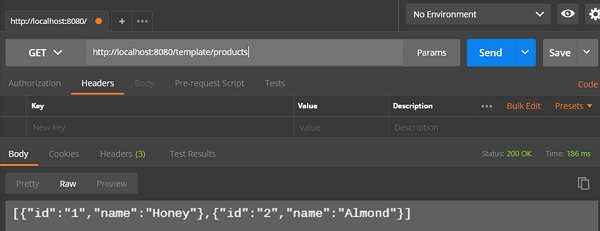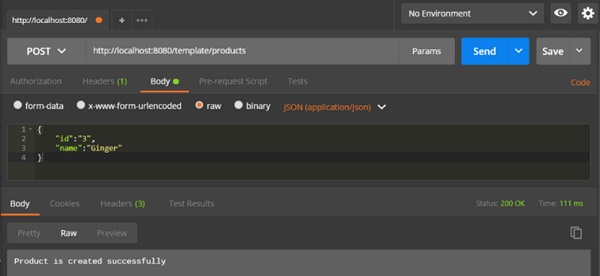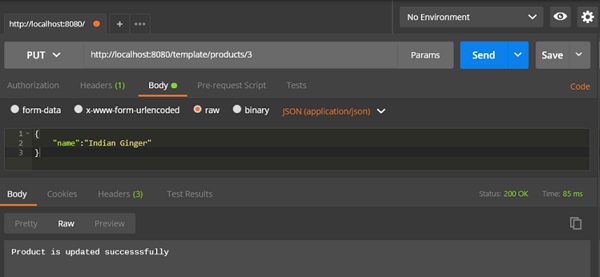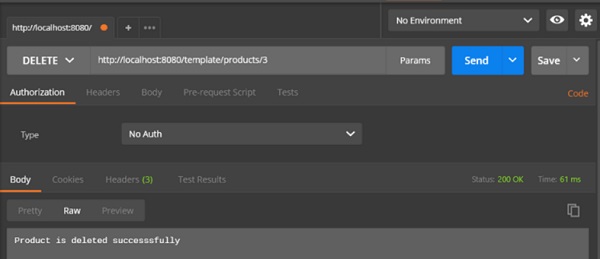Spring Boot - Rest 模板
Rest 模板用于创建使用 RESTful Web 服务的应用程序。 您可以使用 exchange() 方法来使用所有 HTTP 方法的 Web 服务。 下面给出的代码显示了如何为 Rest 模板创建 Bean 以自动连接 Rest 模板对象。
package com.tutorialspoint.demo;
import org.springframework.boot.SpringApplication;
import org.springframework.boot.autoconfigure.SpringBootApplication;
import org.springframework.context.annotation.Bean;
import org.springframework.web.client.RestTemplate;
@SpringBootApplication
public class DemoApplication {
public static void main(String[] args) {
SpringApplication.run(DemoApplication.class, args);
}
@Bean
public RestTemplate getRestTemplate() {
return new RestTemplate();
}
}
GET
使用 RestTemplate - exchange() 方法使用 GET API
假设此 URL http://localhost:8080/products 返回以下 JSON,我们将使用以下代码使用 Rest 模板使用此 API 响应 −
[
{
"id": "1",
"name": "Honey"
},
{
"id": "2",
"name": "Almond"
}
]
您必须按照给定的要点来使用 API −
- 自动装配 Rest 模板对象。
- 使用 HttpHeaders 设置请求标头。
- 使用 HttpEntity 包装请求对象。
- 为 Exchange() 方法提供 URL、HttpMethod 和返回类型。
@RestController
public class ConsumeWebService {
@Autowired
RestTemplate restTemplate;
@RequestMapping(value = "/template/products")
public String getProductList() {
HttpHeaders headers = new HttpHeaders();
headers.setAccept(Arrays.asList(MediaType.APPLICATION_JSON));
HttpEntity <String> entity = new HttpEntity<String>(headers);
return restTemplate.exchange("
http://localhost:8080/products", HttpMethod.GET, entity, String.class).getBody();
}
}
POST
使用 RestTemplate - exchange() 方法使用 POST API
假设这个 URL http://localhost:8080/products 返回如下所示的响应,我们将使用 Rest Template 使用这个 API 响应。
下面给出的代码是请求正文 −
{
"id":"3",
"name":"Ginger"
}
下面给出的代码是响应体 −
Product is created successfully
您必须遵循以下几点才能使用 API −
自动装配 Rest 模板对象。
使用 HttpHeaders 设置请求标头。
使用 HttpEntity 来包装请求对象。 在这里,我们包装 Product 对象以将其发送到请求正文。
为 exchange() 方法提供 URL、HttpMethod 和返回类型。
@RestController
public class ConsumeWebService {
@Autowired
RestTemplate restTemplate;
@RequestMapping(value = "/template/products", method = RequestMethod.POST)
public String createProducts(@RequestBody Product product) {
HttpHeaders headers = new HttpHeaders();
headers.setAccept(Arrays.asList(MediaType.APPLICATION_JSON));
HttpEntity<Product> entity = new HttpEntity<Product>(product,headers);
return restTemplate.exchange(
"http://localhost:8080/products", HttpMethod.POST, entity, String.class).getBody();
}
}
PUT
使用 RestTemplate - exchange() 方法使用 PUT API
假设此 URL http://localhost:8080/products/3 返回以下响应,我们将使用 Rest Template 使用此 API 响应。
下面给出的代码是请求正文 −
{
"name":"Indian Ginger"
}
下面给出的代码是响应体 −
Product is updated successfully
您必须遵循以下几点才能使用 API −
自动装配 Rest 模板对象。
使用 HttpHeaders 设置请求标头。
使用 HttpEntity 包装请求对象。 在这里,我们包装 Product 对象以将其发送到请求正文。
为 exchange() 方法提供 URL、HttpMethod 和返回类型。
@RestController
public class ConsumeWebService {
@Autowired
RestTemplate restTemplate;
@RequestMapping(value = "/template/products/{id}", method = RequestMethod.PUT)
public String updateProduct(@PathVariable("id") String id, @RequestBody Product product) {
HttpHeaders headers = new HttpHeaders();
headers.setAccept(Arrays.asList(MediaType.APPLICATION_JSON));
HttpEntity<Product> entity = new HttpEntity<Product>(product,headers);
return restTemplate.exchange(
"http://localhost:8080/products/"+id, HttpMethod.PUT, entity, String.class).getBody();
}
}
DELETE
使用 RestTemplate - exchange() 方法使用 DELETE API
假设这个 URL http://localhost:8080/products/3 返回下面给出的响应,我们将使用 Rest Template 使用这个 API 响应。
下面显示的这行代码就是响应体 −
Product is deleted successfully
您必须遵循以下几点才能使用 API −
自动装配 Rest 模板对象。
使用 HttpHeaders 设置请求标头。
使用 HttpEntity 包装请求对象。
为 exchange() 方法提供 URL、HttpMethod 和返回类型。
@RestController
public class ConsumeWebService {
@Autowired
RestTemplate restTemplate;
@RequestMapping(value = "/template/products/{id}", method = RequestMethod.DELETE)
public String deleteProduct(@PathVariable("id") String id) {
HttpHeaders headers = new HttpHeaders();
headers.setAccept(Arrays.asList(MediaType.APPLICATION_JSON));
HttpEntity<Product> entity = new HttpEntity<Product>(headers);
return restTemplate.exchange(
"http://localhost:8080/products/"+id, HttpMethod.DELETE, entity, String.class).getBody();
}
}
下面给出了完整的 Rest 模板控制器类文件 −
package com.tutorialspoint.demo.controller;
import java.util.Arrays;
import org.springframework.beans.factory.annotation.Autowired;
import org.springframework.http.HttpEntity;
import org.springframework.http.HttpHeaders;
import org.springframework.http.HttpMethod;
import org.springframework.http.MediaType;
import org.springframework.web.bind.annotation.PathVariable;
import org.springframework.web.bind.annotation.RequestBody;
import org.springframework.web.bind.annotation.RequestMapping;
import org.springframework.web.bind.annotation.RequestMethod;
import org.springframework.web.bind.annotation.RestController;
import org.springframework.web.client.RestTemplate;
import com.tutorialspoint.demo.model.Product;
@RestController
public class ConsumeWebService {
@Autowired
RestTemplate restTemplate;
@RequestMapping(value = "/template/products")
public String getProductList() {
HttpHeaders headers = new HttpHeaders();
headers.setAccept(Arrays.asList(MediaType.APPLICATION_JSON));
HttpEntity<String> entity = new HttpEntity<String>(headers);
return restTemplate.exchange(
"http://localhost:8080/products", HttpMethod.GET, entity, String.class).getBody();
}
@RequestMapping(value = "/template/products", method = RequestMethod.POST)
public String createProducts(@RequestBody Product product) {
HttpHeaders headers = new HttpHeaders();
headers.setAccept(Arrays.asList(MediaType.APPLICATION_JSON));
HttpEntity<Product> entity = new HttpEntity<Product>(product,headers);
return restTemplate.exchange(
"http://localhost:8080/products", HttpMethod.POST, entity, String.class).getBody();
}
@RequestMapping(value = "/template/products/{id}", method = RequestMethod.PUT)
public String updateProduct(@PathVariable("id") String id, @RequestBody Product product) {
HttpHeaders headers = new HttpHeaders();
headers.setAccept(Arrays.asList(MediaType.APPLICATION_JSON));
HttpEntity<Product> entity = new HttpEntity<Product>(product,headers);
return restTemplate.exchange(
"http://localhost:8080/products/"+id, HttpMethod.PUT, entity, String.class).getBody();
}
@RequestMapping(value = "/template/products/{id}", method = RequestMethod.DELETE)
public String deleteProduct(@PathVariable("id") String id) {
HttpHeaders headers = new HttpHeaders();
headers.setAccept(Arrays.asList(MediaType.APPLICATION_JSON));
HttpEntity<Product> entity = new HttpEntity<Product>(headers);
return restTemplate.exchange(
"http://localhost:8080/products/"+id, HttpMethod.DELETE, entity, String.class).getBody();
}
}
Spring Boot 应用程序类 - DemoApplication.java 的代码如下所示 −
package com.tutorialspoint.demo;
import org.springframework.boot.SpringApplication;
import org.springframework.boot.autoconfigure.SpringBootApplication;
@SpringBootApplication
public class DemoApplication {
public static void main(String[] args) {
SpringApplication.run(DemoApplication.class, args);
}
}
Maven 构建的代码 – pom.xml 如下所示 −
<?xml version = "1.0" encoding = "UTF-8"?>
<project xmlns = "http://maven.apache.org/POM/4.0.0"
xmlns:xsi = "http://www.w3.org/2001/XMLSchema-instance"
xsi:schemaLocation = "http://maven.apache.org/POM/4.0.0
http://maven.apache.org/xsd/maven-4.0.0.xsd">
<modelVersion>4.0.0</modelVersion>
<groupId>com.tutorialspoint</groupId>
<artifactId>demo</artifactId>
<version>0.0.1-SNAPSHOT</version>
<packaging>jar</packaging>
<name>demo</name>
<description>Demo project for Spring Boot</description>
<parent>
<groupId>org.springframework.boot</groupId>
<artifactId>spring-boot-starter-parent</artifactId>
<version>1.5.8.RELEASE</version>
<relativePath/>
</parent>
<properties>
<project.build.sourceEncoding>UTF-8</project.build.sourceEncoding>
<project.reporting.outputEncoding>UTF-8</project.reporting.outputEncoding>
<java.version>1.8</java.version>
</properties>
<dependencies>
<dependency>
<groupId>org.springframework.boot</groupId>
<artifactId>spring-boot-starter-web</artifactId>
</dependency>
<dependency>
<groupId>org.springframework.boot</groupId>
<artifactId>spring-boot-starter-test</artifactId>
<scope>test</scope>
</dependency>
</dependencies>
<build>
<plugins>
<plugin>
<groupId>org.springframework.boot</groupId>
<artifactId>spring-boot-maven-plugin</artifactId>
</plugin>
</plugins>
</build>
</project>
Gradle 构建 - build.gradle 的代码如下 −
buildscript {
ext {
springBootVersion = '1.5.8.RELEASE'
}
repositories {
mavenCentral()
}
dependencies {
classpath("org.springframework.boot:spring-boot-gradle-plugin:${springBootVersion}")
}
}
apply plugin: 'java'
apply plugin: 'eclipse'
apply plugin: 'org.springframework.boot'
group = 'com.tutorialspoint'
version = '0.0.1-SNAPSHOT'
sourceCompatibility = 1.8
repositories {
mavenCentral()
}
dependencies {
compile('org.springframework.boot:spring-boot-starter-web')
testCompile('org.springframework.boot:spring-boot-starter-test')
}
您可以创建一个可执行的 JAR 文件,并使用以下 Maven 或 Gradle 命令运行 Spring Boot 应用程序 −
对于 Maven,您可以使用下面给出的命令 −
mvn clean install
在"BUILD SUCCESS"之后,您可以在目标目录下找到 JAR 文件。
对于 Gradle,您可以使用如下所示的命令 −
gradle clean build
在"BUILD SUCCESSFUL"之后,您可以在 build/libs 目录下找到 JAR 文件。
现在,使用以下命令运行 JAR 文件 −
java –jar <JARFILE>
现在,应用程序已在 Tomcat 端口 8080 上启动。

现在在 POSTMAN 应用程序中点击以下 URL,您可以看到输出。
通过 Rest 模板获取产品 − http://localhost:8080/template/products

创建产品 POST − http://localhost:8080/template/products

更新产品 PUT − http://localhost:8080/template/products/3

删除产品 − http://localhost:8080/template/products/3


